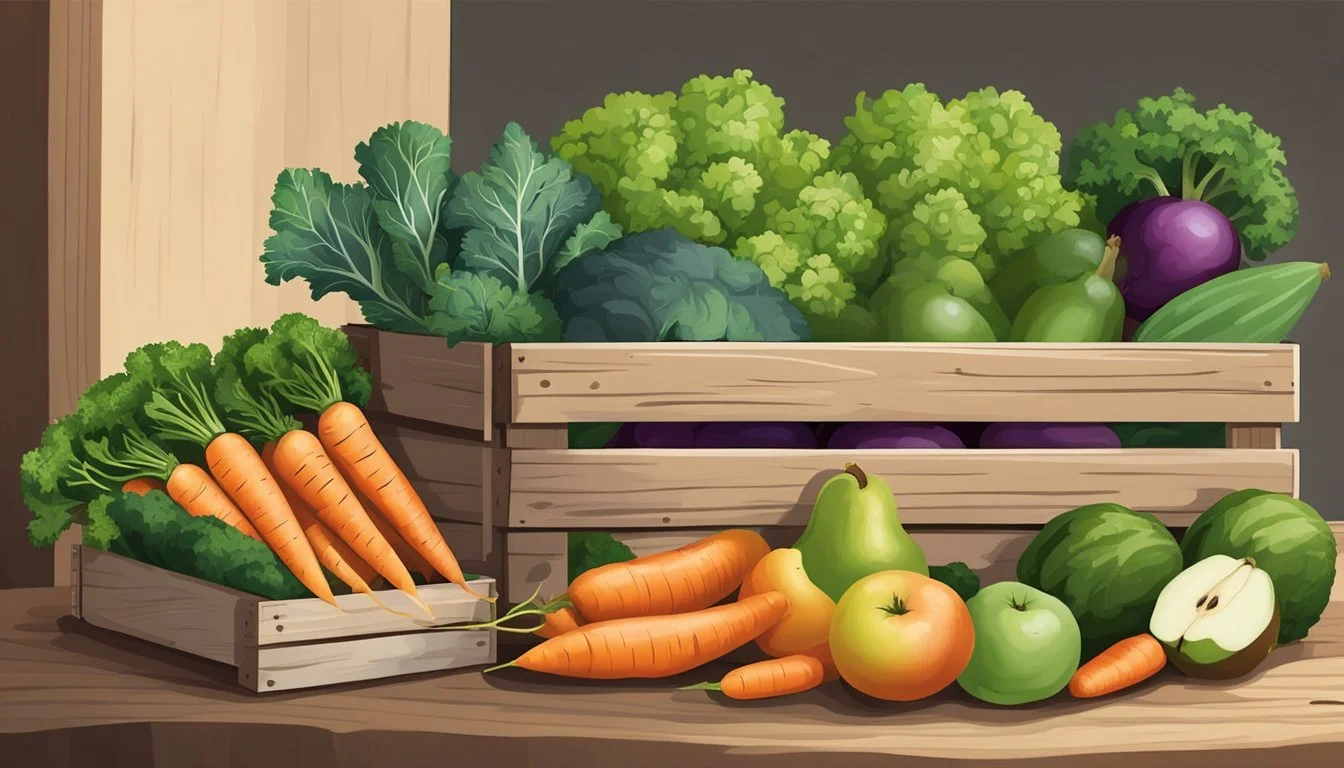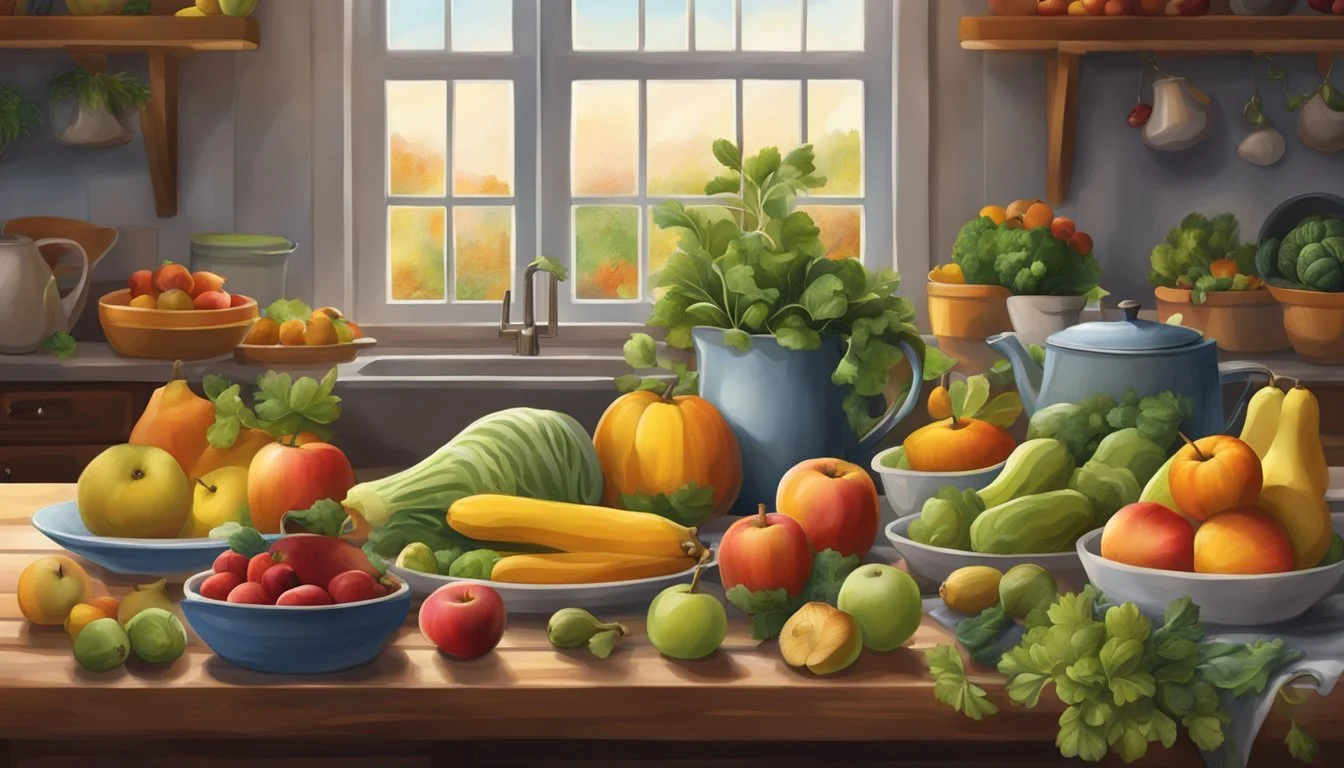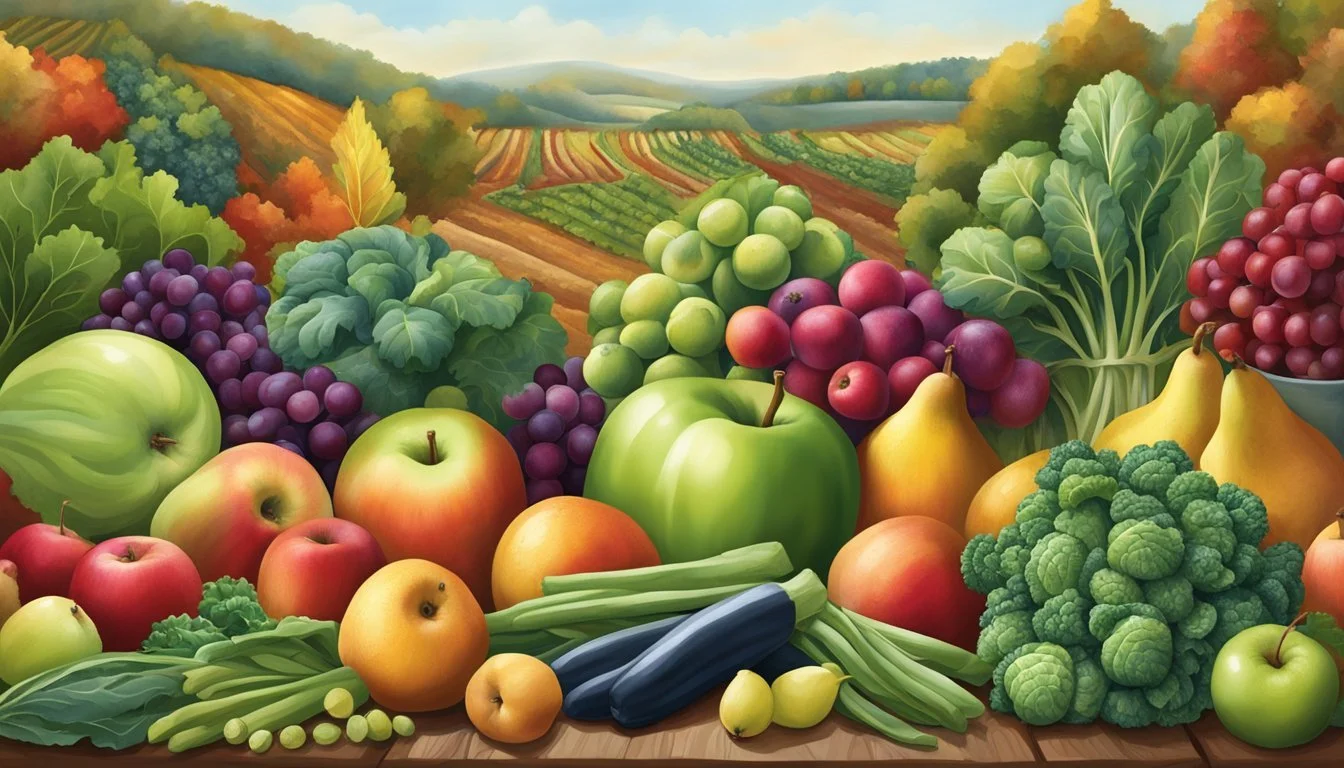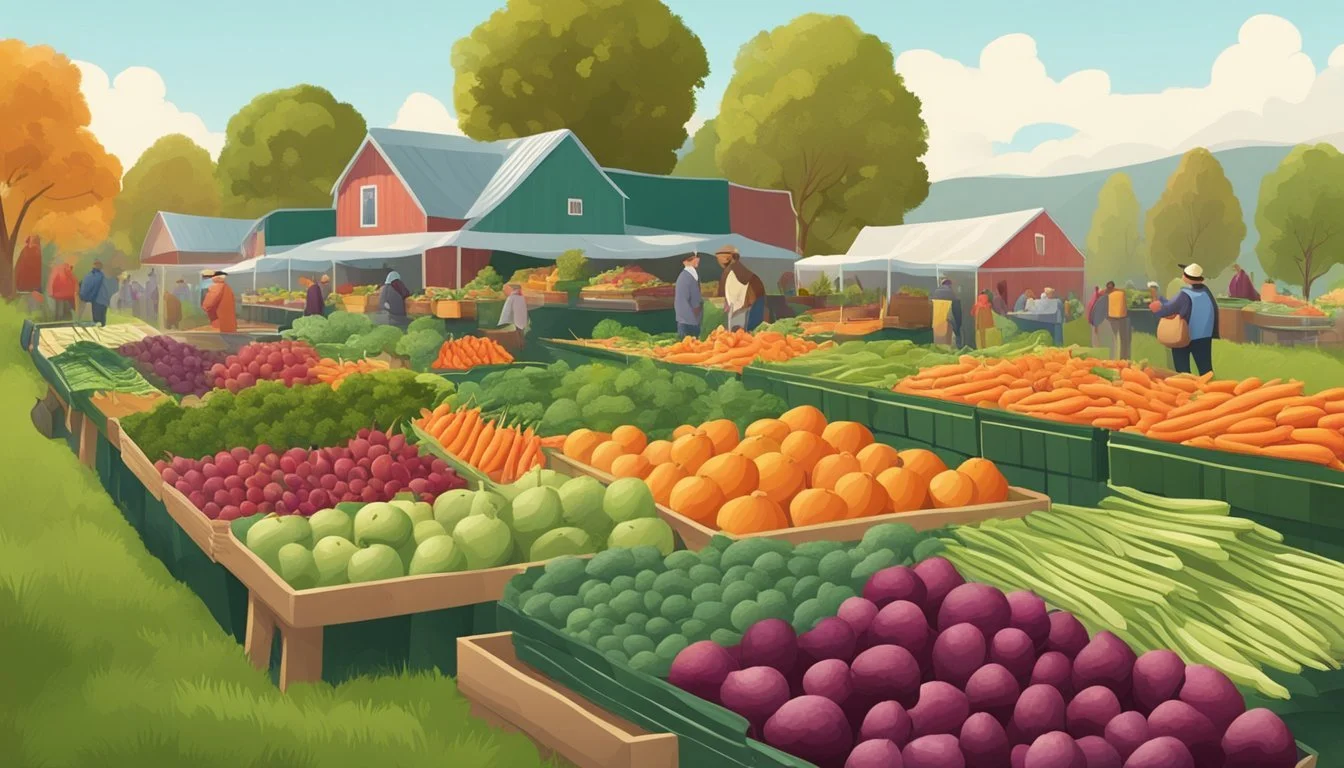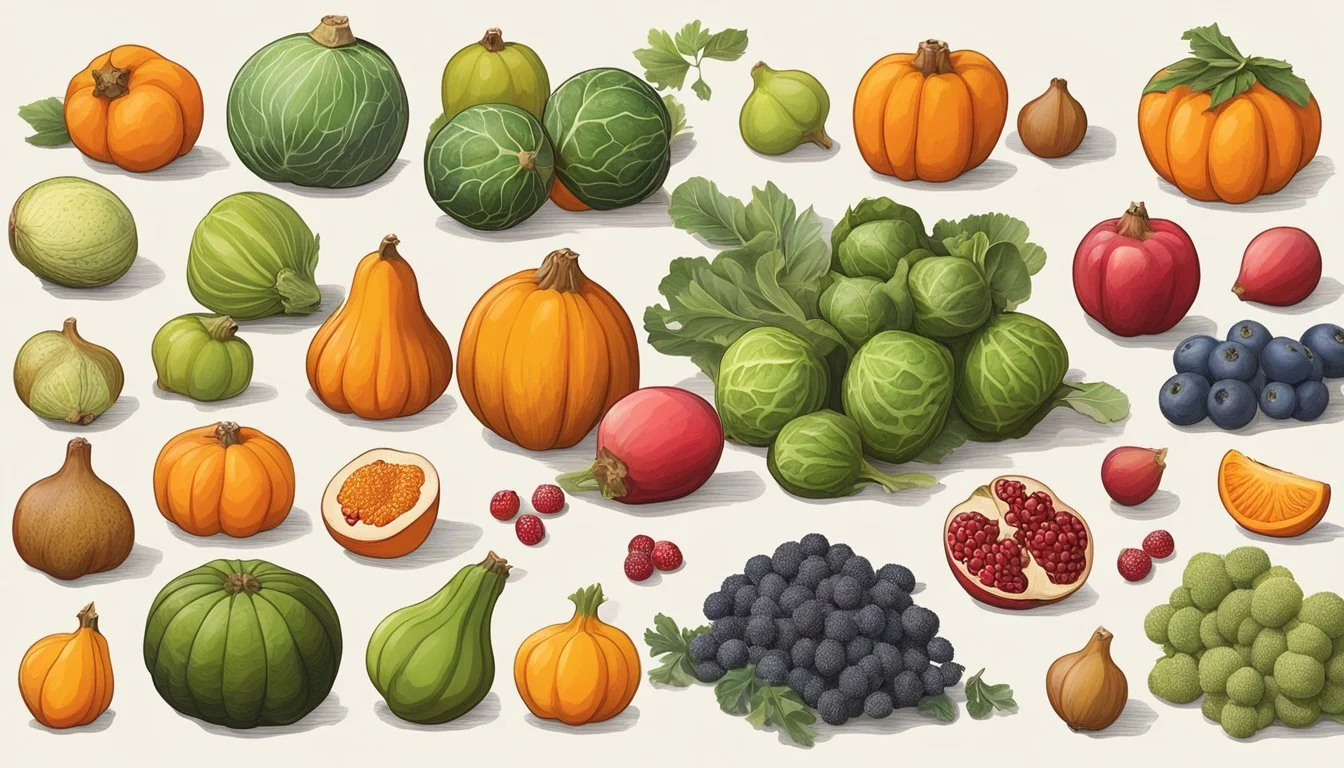Washington Seasonal Fruit & Vegetables in December
Your Guide to Fresh Produce
This Article is Part of our Washington Seasonal Fruit & Veg Calendar
December in Washington is a time when the landscape transforms under a colder, dormant season, but it does not signify a lack of fresh produce. Quite the contrary, it offers a range of seasonal fruits and vegetables that thrive in the cooler climate, reflecting the state's agricultural diversity. Root vegetables and hardy greens are predominantly featured in the local markets, harvested at the peak of their flavor and nutritional value.
Seasonal produce during this time includes staples such as parsnips, which bring a sweet, earthy flavor to winter dishes, and garlic and onions, essential for their pungent notes and depth. They remain in abundant supply and are often stored to last through the colder months. Potatoes, turnips, and rutabagas are also readily available, offering heartiness to a variety of culinary applications, from comforting soups to roasted side dishes.
Winter's offerings extend beyond root vegetables, with the inclusion of mushrooms, cauliflower (how long does cauliflower last?), and broccoli, each contributing unique textures and tastes to the winter palette. These vegetables not only persevere through the winter chill but also provide the foundation for nutritious and warming meals that cater to the season's craving for wholesome, fulfilling produce.
Seasonal Overview
In December, consumers embrace the seasonal offerings from Washington state's diverse agricultural landscape. The availability of fresh, local produce shifts to accommodate the colder winter climate.
Importance of Seasonality
Seasonality lies at the heart of Washington's produce market, influencing both agriculture and consumer choices. During winter, the supply of fresh, seasonal vegetables and fruits not only supports local economies but also promotes environmental sustainability and provides nutritional benefits. Consumers can expect a range of produce that thrives in the winter conditions of the state.
Washington's Climate and Agriculture
Washington's climate is characterized by cool, wet winters and warm, dry summers—conditions that dictate the type of crops grown each season. The state's agricultural industry adapts to these seasonal changes, with winter favoring hardy root vegetables and storage crops that are less sensitive to the cold. The following list highlights typical December offerings:
Root Vegetables: potatoes, carrots, beets (how long do beets last?), and turnips
Leafy Greens: kale, (What wine goes well with kale?) chard, and collards
Alliums: garlic and onions
Winter Squash: varieties like acorn, butternut, and delicata
Apples and Pears: stored from fall harvest and available fresh
Through the cultivation of these winter-hardy varieties, Washington's agriculture continues to thrive even in the coldest months.
Fruits in Season
In December, Washington's fruit selection narrows due to the cold climate, yet certain fruits are at their peak. Citrus and hearty tree fruits come to the forefront, providing vibrant flavors and nutritional benefits during the winter months.
Citrus Fruits
The range of citrus fruits in Washington during December includes several varieties. Oranges and clementines are particularly popular for their balance of tartness and sweetness, and their juices are rich in vitamin C, an essential nutrient during the colder season.
Oranges: Available and sweet, perfect for juicing or eating fresh.
Clementines: Small, sweet, and easy to peel, making them a favored snack.
Tree Fruits
In December, tree fruits like apples and pears continue to be available thanks to modern storage techniques that keep them fresh long after their harvest in the fall.
Apples: Enjoy a variety of apples that retain their crispness and flavor.
Pears: These fruits remain juicy and are ideal for both eating raw and cooking.
Berry Varieties
Berry options are limited in December, but some hardy varieties can be found.
Cranberries: A deep red berry, cranberries are often available fresh this time of year and are a staple in many winter recipes.
While berries like strawberries and raspberries are out of season, imported or greenhouse-grown berries can sometimes be found in stores, but they are not at their peak freshness or flavor during this time.
Vegetables in Season
In December, Washington is abundant with a variety of vegetables that thrive in the cooler weather, offering fresh farm-to-table flavors for seasonal dishes.
Root Vegetables
Root vegetables such as beets, carrots, and turnips are in full swing during December in Washington. The cold soil enhances their natural sweetness, making them a hearty choice for winter meals. Other notable root vegetables include parsnips, rutabagas, and sweet potatoes, which are versatile for a range of recipes from roasts to soups.
Beets: Earthy and sweet, perfect for roasting.
Carrots: Crisp and versatile, used in both sweet and savory dishes.
Rutabagas and Turnips: Starchy and rich, ideal for mashes and stews.
Cruciferous Vegetables
Washington's December harvest also includes an array of cruciferous vegetables like broccoli, cauliflower, and Brussels sprouts (how long do brussels sprouts last?). These vegetables are packed with nutrients and are known for their cancer-fighting properties. They can be enjoyed roasted, steamed, or even raw in salads.
Broccoli: Rich in vitamins and best enjoyed steamed or stir-fried.
Cauliflower: Comes in white and purple varieties, great for roasting or as a low-carb substitute.
Brussels sprouts: They develop a nutty flavor when roasted, a beloved winter side dish.
Leafy Greens
Leafy greens such as kale, spinach, and cabbage remain robust even as the temperatures drop. They are a staple for Washingtonians looking to boost their intake of greens during the colder months. These greens are essential for salads, sautés, and adding a fresh element to warm dishes.
Kale: Hardy and nutrient-dense, excellent in salads and chips.
Spinach: Tender and mild, perfect for salads or quickly wilting into warm dishes.
Cabbage: Crunchy and sweet, commonly used in slaws or fermented to make sauerkraut.
Alliums
The allium family, including garlic, onions, leeks, and shallots, is essential for adding depth and flavor to winter dishes. Garlic and onions, in particular, are known for their long storage life and their ability to withstand Washington's chilly winter.
Garlic: Aromatic and flavorful, used as a base for countless recipes.
Onions: Pungent when raw, but mellow and sweet once cooked.
Leeks and Shallots: Milder than onions, ideal for soups and sauces.
Flavor and Culinary Uses
December fruits and vegetables in Washington offer a range of flavors from the earthiness of root vegetables to the tartness of berries. They are versatile in preparation, whether consumed fresh, roasted, or incorporated into warming dishes like stews and soups.
Fresh Consumption
When it comes to fresh consumption, Brussels sprouts and cabbage deliver crisp textures that complement the hearty meals typical of December. Berries blackberries and blueberries may still be found, offering a tart burst of flavor that can be enjoyed raw or in fruit salads.
Cooking Techniques
Cooked preparations open a spectrum of possibilities for these ingredients. Root vegetables, such as beets and turnips, develop a sweeter, more concentrated flavor when roasted. They can also become the backbone of flavor when simmered in stews and soups.
Roasted:
Beets: Roast to enhance their earthy sweetness.
Brussels Sprouts: Caramelize to release nutty flavors.
Stews and Soups:
Cabbage: Adds sweetness and tenderness to stews.
Root Vegetables: Infuse a deep, savory essence into soups.
Herbs and Aromatics
The addition of herbs and aromatics elevates the distinct flavors of winter produce. Sage and thyme offer a piney and earthy note that complements many root vegetables. For a hint of licorice (how long does licorice last?)-like flavor, anise can be used in dishes with cabbage or infused in compotes and desserts featuring the season's berries.
Sage: Perfect with roasted root vegetables and adds depth to soups.
Thyme: Versatile in various dishes, from roasted vegetables to berry compotes.
Anise: Pair with cabbage in cooked dishes, or fresh berries in dessert.
Nutrition and Health Benefits
As winter takes hold in Washington, the selection of seasonal produce includes a variety of fruits and vegetables packed with essential nutrients. These seasonal offerings are particularly rich in vitamins and minerals, as well as dietary fiber, contributing to a balanced diet.
Vitamins and Minerals
Seasonal fruits and vegetables available in December, such as root vegetables and hearty greens, are excellent sources of vitamins and essential minerals. For instance:
Root Vegetables: Carrots and beets contain Vitamin C, potassium, and a range of B-vitamins.
Winter Squash: Offers Vitamin A and Vitamin E, crucial for maintaining healthy skin and eyesight.
Listed nutrients help bolster the immune system during the colder months and support overall health.
Dietary Fiber
The fiber content in winter produce is significant due to the presence of:
Root Vegetables: High in fiber, they aid in digestion and maintaining a healthy gut.
Leafy Greens: Such as kale and Swiss chard, offer a good amount of fiber which assists in regulating blood sugar levels.
Dietary fiber from these sources promotes satiety, helping one feel full longer, which can be beneficial for weight management during holiday seasons.
Shopping and Preparation Tips
When shopping for Washington's seasonal fruits and vegetables in December, consumers should prioritize freshness and quality. They should also be mindful of the best ways to store their produce to maintain flavor and nutrition.
Selecting Quality Produce
Shoppers at markets should look for vibrant colors and firm textures in fruits and vegetables. Brussels sprouts, a common winter vegetable, should have tightly packed leaves and a bright green hue. Chefs often recommend that one should avoid any Brussels sprouts with yellowing leaves, as this indicates they are past their prime. For fruits like pears, which are ripe in December, gently press near the stem; a slight yield indicates ripeness.
For root vegetables such as beets and turnips, they should feel heavy for their size, a sign of juiciness and freshness. Additionally, the skin should be smooth and free of deep cuts or bruises. Farmers suggest choosing root vegetables with the greens still attached if possible, as this can be a freshness indicator.
Storage Recommendations
Once the produce is brought home, proper storage is essential to extend its shelf life and preserve essential nutrients. Here are some guidelines:
Beets: Store in a plastic bag in the crisper drawer of the refrigerator; they can last up to two weeks.
Brussels Sprouts: Keep them in an open container in the fridge, preferably with a damp towel on top to retain moisture.
Pears: If they are ripe, they should be eaten within a couple of days. Unripe pears can be stored at room temperature until they reach desired ripeness.
For optimal storage, consumers should avoid washing fruits and vegetables until they are ready to eat or cook them. Excess moisture can promote mold growth and speed up decay.
Recipes and Serving Ideas
This section provides various ways to incorporate Washington's seasonal produce into delicious meals during December. One can leverage the freshness of local fruits and vegetables to create main courses, side dishes, and salads with a distinctively seasonal flair.
Main Courses
In December, root vegetables and winter squash serve as hearty bases for main courses. Recipes such as roasted root vegetable stews or squash lasagna highlight the deep flavors of produce like turnips, rutabagas, and various types of winter squash, like butternut and acorn. These dishes are not only comforting but also packed with nutrients.
Side Dishes
Complementing any main course, side dishes in December can include Brussels sprouts caramelized with a splash of balsamic vinegar or mashed rutabagas with a hint of nutmeg (how long does nutmeg last?). Side dishes that involve cabbage can be a crisp addition, such as a warm red cabbage slaw featuring local apples for a sweet-tart note.
Salads and Dressings
Salads may feature arugula as a peppery base, punctuated by seasonal fruits like Comice pears, which add a juicy sweetness. Dressings for these salads can be made from local ingredients as well, perhaps a citrus vinaigrette using December’s bright and fruity citrus, or a pomegranate dressing to embrace the tart and colorful pomegranate seeds (how long do pomegranate seeds last?) that are available this time of year.
Supporting Local Agriculture
In December, Washington's local agriculture can still thrive with consumer support through various channels such as farmers' markets and Community Supported Agriculture programs. Both platforms offer unique opportunities for consumers to access fresh, seasonal veggies and bolster the connection between farmers, markets, and chefs.
Farmers' Markets
Farmers' markets in Washington provide a direct pipeline to seasonal produce even during the colder months. Consumers can find an array of late-season and cold-tolerant vegetables, from root crops to winter greens, upholding the farm-to-table ethos that many local chefs value for its freshness and quality. By shopping at these markets, consumers help sustain the agricultural community and ensure farmers receive a fair return for their labor.
Notable December Produce:
Beets
Brussels Sprouts
Carrots
Kale
Community Supported Agriculture (CSA)
Community Supported Agriculture programs represent a commitment between consumers and farmers, where individuals purchase "shares" of a farm's harvest in advance. In December, these shares typically include storage-friendly vegetables and sometimes preserved goods. CSA members benefit from the diversity of fresh produce selected by experienced farmers, while farmers benefit from a stable income source throughout the year.
CSA Highlights:
Pre-paid shares: Ensures financial support for farmers
Seasonal offerings: A variety of veggies tailored to the time of year
Direct relationships: Fosters a sense of community between farmers and consumers
Seasonal Eating Challenges
December in Washington presents unique challenges for consumers who prefer to eat seasonally due to the limited availability of fresh produce.
Availability and Accessibility
In December, the range of fresh, in-season produce narrows significantly. The summer bounty of July and September, such as blueberries, is long past. In-season fruits such as cranberries are available, but the variety is much less compared to the warmer months. Additionally, access to fresh, local produce might be constrained by factors such as reduced farmers' market hours and fewer CSA (Community Supported Agriculture) offerings.
In-Season Availability:
Fruits: predominantly stored apples and fresh cranberries
Vegetables: root crops like turnips, parsnips, and potatoes
Shoppers may face difficulty finding fresh seasonal specialties, and the cost may be higher due to decreased supply or the need for indoor cultivation methods like greenhouses.
Overcoming Off-Season Cravings
Dealing with cravings for off-season produce such as summer fruits requires both creativity and planning. Preserving techniques such as canning, drying, and freezing during the peak season can ensure that summer flavors are enjoyed throughout the year. Exploring alternative produce that is in-season can also satisfy the desire for fresh food. For example, hearty winter vegetables make for excellent soups and stews that align with December's colder weather.
Strategies to Manage Cravings:
Utilize preserved foods: jams, pickles, frozen fruits and vegetables
Embrace winter produce: create dishes centered on root vegetables and hardy greens



